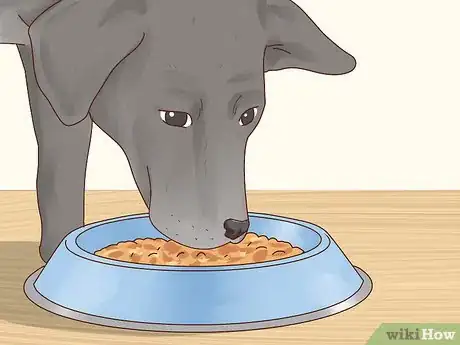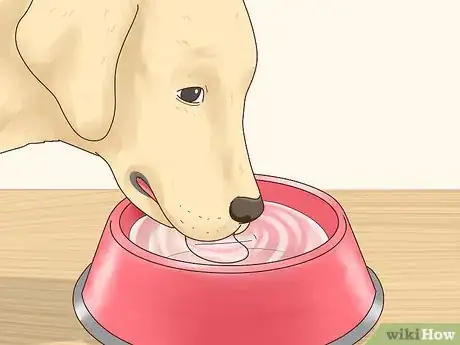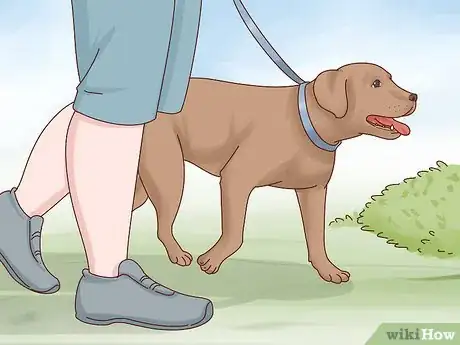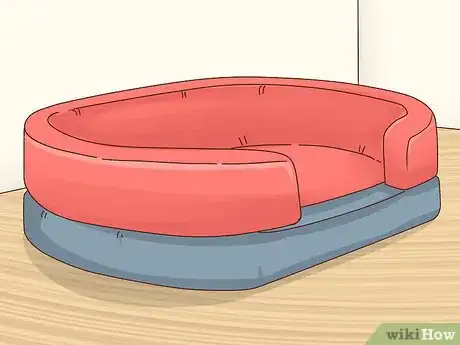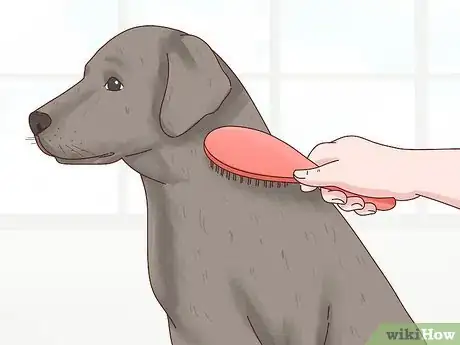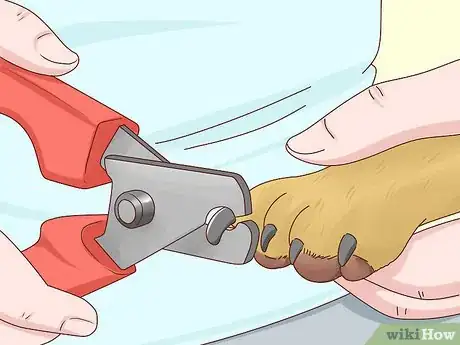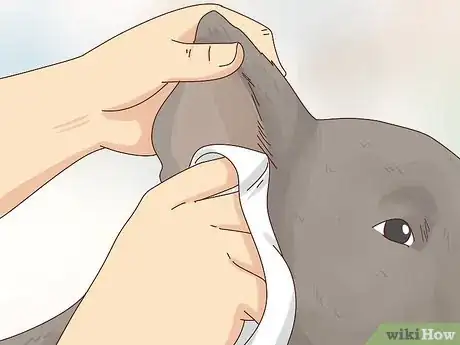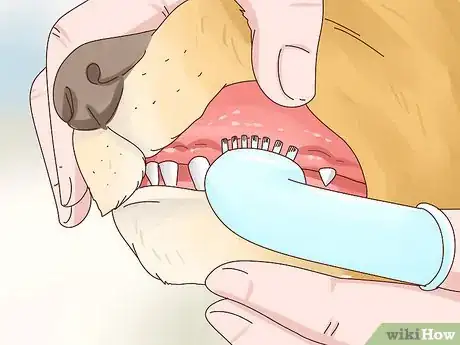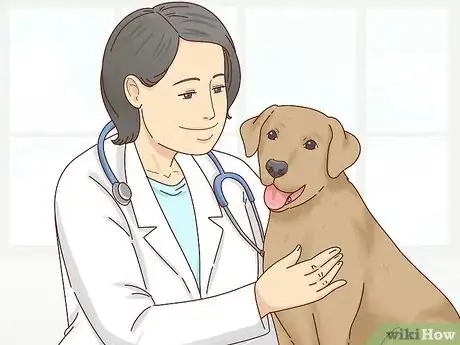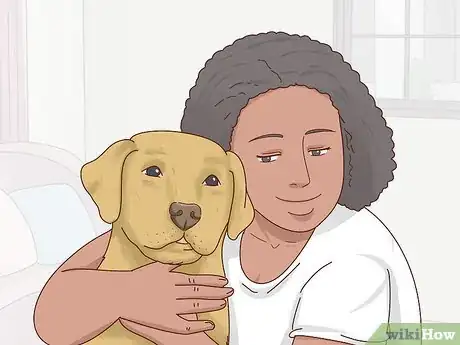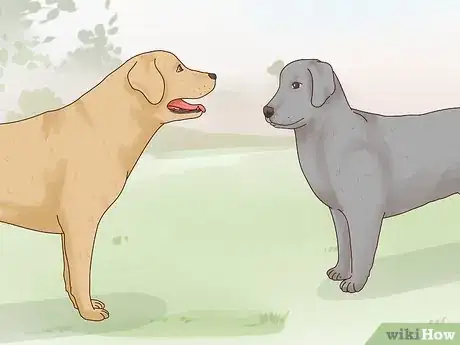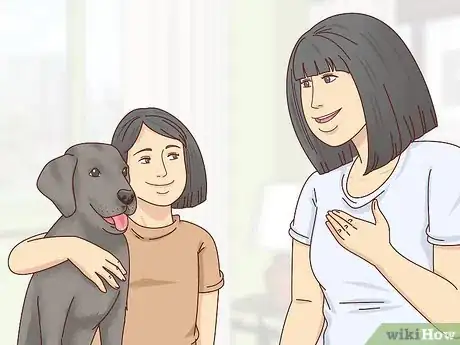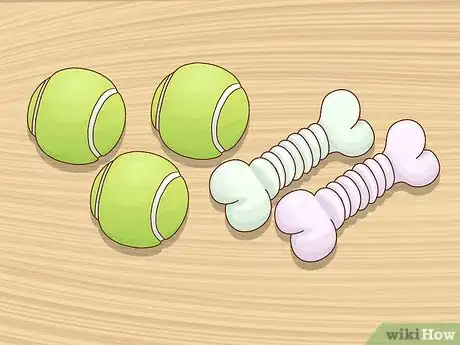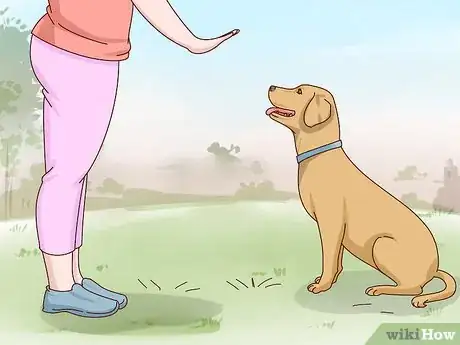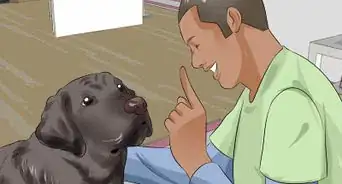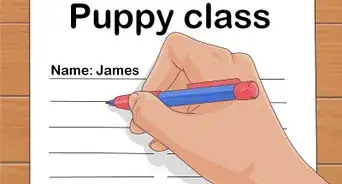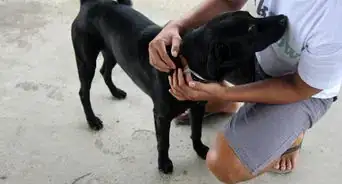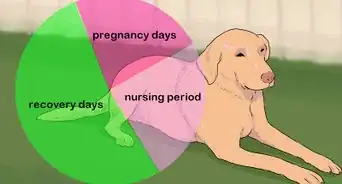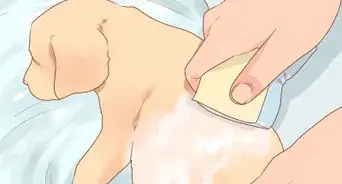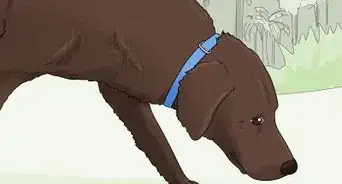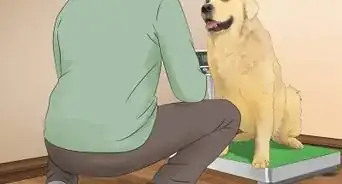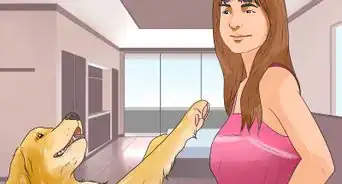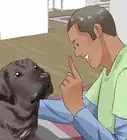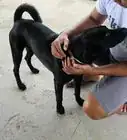This article was co-authored by Colleen Demling-Riley, CPDT-KA, CBCC-KA, CDBC. Colleen Demling-Riley (CPDT-KA, CBCC-KA, CDBC) is a Canine Behavior Consultant and the Founder of Pawtopia Dog Training. With more than 20 years of experience, she specializes in creating and customizing dog management programs for dog owners. She is a Certified Pet Dog Trainer-Knowledge Assessed, Certified Behavior Consultant Canine-Knowledge Assessed, Certified Dog Behavior Consultant, and American Kennel Club Canine Good Citizen Evaluator. Colleen is a member of the International Association of Canine Professionals and has been a featured expert in national media including the New York Times, Woman’s Day, Readers Digest, Cosmopolitan, and Yahoo.com.
There are 16 references cited in this article, which can be found at the bottom of the page.
wikiHow marks an article as reader-approved once it receives enough positive feedback. This article received 33 testimonials and 92% of readers who voted found it helpful, earning it our reader-approved status.
This article has been viewed 534,299 times.
According to the American Kennel Club, labrador retrievers are number one as the most popular breed and one of the best family dogs.[1] They are friendly, outgoing, and active. Whether you have one or are planning on getting one, you’ll need to know how to best care for a labrador retriever and give them the attention they need.
Things You Should Know
- Take your lab on 3 long walks per day if possible so it gets enough exercise.
- Labs love playing fetch, so get your dog toys that it can retrieve for you, like tennis balls.
- Brush your lab once a week during the summer to remove loose hair from its coat.
Steps
Taking Care of Their Basic Needs
-
1Feed it appropriately. Your labrador retriever has a huge appetite. It loves to eat, so it may carry its food bowl around with them, beg for food, or eat unconventional things. This is normal. The exact quantity of food you give your lab depends on which food you're offering and how many calories it contains. Follow the feeding guidelines on the food packaging, and increase or decrease the amount depending on whether the dog loses or gains weight on this ration.[2]
- If your dog is more active than most dogs, then you should increase its food intake accordingly. For instance, if every morning you and your furry friend go for a 5 mile (8 km) jog together, you should consider giving it more food than usual.
- Obviously, you don’t want your labrador to become obese. If you cannot easily feel its rib bones anymore, then you are probably overfeeding it. At the same time, you should not be able to see its rib bones from afar.
-
2Provide plenty of clean, fresh water. Your lab will get very thirsty after exercise and will need to quench that thirst. It will drink more or less water depending on how active it has been and how hot it is outside. Do not limit your dog's water consumption. Unlike food, your dog will regulate itself. Dehydration can be fatal, so don't take any chances.Advertisement
-
3Walk your dog. You lab needs a lot of exercise in order to stay healthy. Walk your lab up to three times a day and if you can, take it on long walks of a couple miles or more.[3] If you have a backyard, make sure that it is big enough for your dog to run around. Small backyards are not suitable for big dogs like labs.
-
4Provide comfortable shelter. Whether your lab lives outside or inside, make sure that it has a space it can call its own. Include a large, durable dog bed. Your lab will paw at the bed constantly to get comfortable. Cheap beds will rip easily and can cause quite a mess.
- Giving your labrador its own bed will also help you train it to stay off of yours, if you are so inclined.[4]
-
5Groom your dog regularly. Labradors are a short-haired breed that come in brown, black, and gold. For most of the year, your lab will remain fairly low maintenance. During the summer, you’ll want to brush it regularly — weekly is best — to remove loose hair from its coat. Brushing your lab will also help remove dirt and spread natural oils throughout.[5]
-
6Trim your lab's nails. Every 2 to 3 months, you should trim your labrador’s nails. If you take your dog on frequent walks, the hard pavement will naturally file its nails down. You can trim them at home or have a vet do it. In general, you can train your lab to sit still to have its nails trimmed. Just offer it a treat after every successful trip to your at-home doggie nail salon. Eventually, your dog will welcome it.[8]
- Be sure to use proper dog nail trimmers. Human nail clippers won't work effectively. Secure your dog's foot in place and then quickly clip off the nail. Do not clip too close to the base of the nail. Doing so can be very painful and cause bleeding. Make sure that the nail does not curve back into the dog's paw or is too sharp to cause accidental damage.[9]
-
7Clean your labrador retriever's floppy ears. Your Labrador's ears can become breeding grounds for bacteria if not cleaned regularly and properly. Check the dog's ears regularly for any excessive or smelly discharge, and seek veterinary advice if you notice anything amiss. If you want to clean the ears, use a specific product designed for the purpose.
- Do not use a Q-Tip to clean inside your dog’s ear. One sudden jerk could seriously damage your dog’s ear canal[10]
-
8Care for your lab's teeth. The more active your lab is the more likely it'll have dental issues. Gum disease, loose teeth, cracked/fractured/broken teeth, root abscesses, and tartar build-up are all problems you’ll need to be on the lookout for. Take your dog to the vet for teeth cleaning 1 or 2 times a year. Routine trips to your vet can also help combat terrible breath. Since you are on the receiving end of so many slobbery kisses, this issue has probably crossed your mind and therefore is just one more reason why you should have your lab's teeth cleaned.[11]
- Vets suggest that you brush your dog's teeth daily or at least several times a week. Purchase a speciality toothbrush and toothpaste from your local pet shop/superstore or your veterinarian. Several kinds of toothpaste are available, many of which come in tasty flavors - e.g. liver, chicken, and peanut butter - that your dog will enjoy.
- Introduce the brush into your dog's mouth gently. Use your fingers to lift your dog's lips in order to expose their teeth. Work the brush in circles and go from tooth to tooth. Its back teeth will be the most difficult to get to, so save them for last. Make sure that you brush both sides of each tooth. Reward you dog with a treat afterwards.[12]
-
9Provide routine veterinary care. Every dog needs certain core vaccinations on a regular basis. It is a good idea to take your dog to the vet at least twice a year for routine exams to monitor its health and to establish a good relationship with your veterinary staff. If your pet should get hurt or is not acting normally, it is always a good idea to visit the veterinarian for an exam and medical care if needed. Your vet will also prescribe necessary medicines (topical and supplemental) to help ward off parasites like fleas and ticks.[13]
- As your dog ages, you may see such health issues as hip dysplasia, epilepsy, or seizures. Your labrador retriever may also experience eye problems.[14] If any of these are happening to your dog, immediately contact your vet and talk about possible treatment solutions or medications. An elderly dog with any such conditions should see a vet every two months or as advised by your vet.[15]
Giving Them the Right Kind of Attention
-
1Show your lab a lot of affection.By nature, it is a very loving dog. If there's anything labrador retrievers love more than food, it is spending time with you - playing, snuggling, or simply following you around..
- Don’t neglect your lab if it wants to play or cuddle up next to your feet while you watch TV. Your labrador retriever has not lost its pack instinct. Most likely, your lab views you as the leader or one of the leaders of its pack. So if you neglect your lab, it will be affected emotionally.
-
2Socialize your labrador retriever. All dogs are territorial. Your lab is no exception. It's natural for them to bark at anything and everything, but when conditioned properly, they aren't so ferocious. Make sure that you spend some time at home and out in public training your lab.[16]
- If you have several dogs, you'll need to gradually introduce your new labrador retriever into the mix. Place them in a room or outdoor space divided by a fence of some kind. Let the dogs get a sense of one another. They learn a lot by smells, so give them 30 minutes or more to just take in their new companion. Next, let them get closer, but keep them on a leash. Do this several times, limiting their exposure to the other animal to half hour increments. Only when you are confident that they won't attack one another should you let them roam freely. Have them play together outside. Let them bond.[17]
- The same rules apply to people. If your labrador retriever is going to get used to being around a lot of people, it needs to be introduced into these environments in a safe way. Keep your lab on a leash. Have surrounding people/strangers pet your dog and be kind to them. Tell them to offer their hand to your dog. Dogs love to smell people's hands in order to assess their scent. Do this frequently. Eventually, your lab will learn that people can be trusted.[18]
-
3Teach your children how to play with your lab. Generally, your labrador retriever will play well with children. However, if you have younger children, you will have to keep tabs on what they're doing with the dog at all times. Make sure the child isn't hurting or threatening your dog in any way or this may result in a physical altercation. Your dog isn't vicious. It doesn't hate your child. It might just feel threatened by it. If it scratches or bites, it is simply reacting instinctually to a threat. Do your best to limit this threat. Be present when your child plays with your labrador.[19]
-
4Supply your lab with plenty of toys. Typically, your lab's favorite toy will be a tennis ball. This probably speaks to their inner "retriever". Since your lab was bred to fetch wild game, it makes sense that it would enjoy playing with something that is meant to be retrieved. You can find a myriad of other toys at any pet superstore. Dog toys are a great way for your dog to play and to burn off excess energy without having to go outside and run around.
-
5Teach your lab basic commands like sit, stay, and come. Teach it how to walk on a leash also. Labrador retrievers are an intelligent breed and are often easy to train - especially, when they are younger. A trained dog is more confident and better behaved. In addition, a dog that will listen to voice commands is safer in the event it is ever off-leash.[20]
- When training your labrador retriever, be sure to reinforce positive behavior rather than chastise for negative. Never hit your labrador retriever. You are trying to build a trusting relationship with your dog, not create a neurotic and scared animal. Dogs that attack people or children without heed are often the product of cruel environments. Don't let your labrador retriever be one of them.[21]
- Try to notice when your dog is doing good behaviors and reward them in those moments. That will make your dog want to repeat that behavior again.
- Training becomes especially important as your dog gets older. If learning and training continue, especially with interactive toys and interactive games, your older dog will stay engaged. This can help extend their lifespan.
Expert Q&A
Did you know you can get expert answers for this article?
Unlock expert answers by supporting wikiHow
-
QuestionWhat is a good age for a Labrador to live?
 Colleen Demling-Riley, CPDT-KA, CBCC-KA, CDBCColleen Demling-Riley (CPDT-KA, CBCC-KA, CDBC) is a Canine Behavior Consultant and the Founder of Pawtopia Dog Training. With more than 20 years of experience, she specializes in creating and customizing dog management programs for dog owners. She is a Certified Pet Dog Trainer-Knowledge Assessed, Certified Behavior Consultant Canine-Knowledge Assessed, Certified Dog Behavior Consultant, and American Kennel Club Canine Good Citizen Evaluator. Colleen is a member of the International Association of Canine Professionals and has been a featured expert in national media including the New York Times, Woman’s Day, Readers Digest, Cosmopolitan, and Yahoo.com.
Colleen Demling-Riley, CPDT-KA, CBCC-KA, CDBCColleen Demling-Riley (CPDT-KA, CBCC-KA, CDBC) is a Canine Behavior Consultant and the Founder of Pawtopia Dog Training. With more than 20 years of experience, she specializes in creating and customizing dog management programs for dog owners. She is a Certified Pet Dog Trainer-Knowledge Assessed, Certified Behavior Consultant Canine-Knowledge Assessed, Certified Dog Behavior Consultant, and American Kennel Club Canine Good Citizen Evaluator. Colleen is a member of the International Association of Canine Professionals and has been a featured expert in national media including the New York Times, Woman’s Day, Readers Digest, Cosmopolitan, and Yahoo.com.
Canine Behavior Consultant
-
QuestionHow can I help a puppy that has loose stools?
 Pippa Elliott, MRCVSDr. Elliott, BVMS, MRCVS is a veterinarian with over 30 years of experience in veterinary surgery and companion animal practice. She graduated from the University of Glasgow in 1987 with a degree in veterinary medicine and surgery. She has worked at the same animal clinic in her hometown for over 20 years.
Pippa Elliott, MRCVSDr. Elliott, BVMS, MRCVS is a veterinarian with over 30 years of experience in veterinary surgery and companion animal practice. She graduated from the University of Glasgow in 1987 with a degree in veterinary medicine and surgery. She has worked at the same animal clinic in her hometown for over 20 years.
Veterinarian Loose stools can be caused by stress (such as going to a new home), a change of diet, but also infections with worms or other parasites such a giardia, and certain bacterial infections. If you've only had the puppy a couple of days and he's bright and well, then put him on a bland diet of chicken and rice with the addition of doggy probiotics for 4-5 days. If the loose stools persist then give the vet a fecal sample so they can check for infection or parasites. But if the puppy is not 100% bouncy and happy, then don't delay and get him checked out by a vet.
Loose stools can be caused by stress (such as going to a new home), a change of diet, but also infections with worms or other parasites such a giardia, and certain bacterial infections. If you've only had the puppy a couple of days and he's bright and well, then put him on a bland diet of chicken and rice with the addition of doggy probiotics for 4-5 days. If the loose stools persist then give the vet a fecal sample so they can check for infection or parasites. But if the puppy is not 100% bouncy and happy, then don't delay and get him checked out by a vet. -
QuestionMy dog is now 2 months old. Which type of food should I feed him?
 Pippa Elliott, MRCVSDr. Elliott, BVMS, MRCVS is a veterinarian with over 30 years of experience in veterinary surgery and companion animal practice. She graduated from the University of Glasgow in 1987 with a degree in veterinary medicine and surgery. She has worked at the same animal clinic in her hometown for over 20 years.
Pippa Elliott, MRCVSDr. Elliott, BVMS, MRCVS is a veterinarian with over 30 years of experience in veterinary surgery and companion animal practice. She graduated from the University of Glasgow in 1987 with a degree in veterinary medicine and surgery. She has worked at the same animal clinic in her hometown for over 20 years.
Veterinarian A growing puppy needs a very special combination of proteins, vitamins, and minerals to ensure healthy bone growth. The easiest way to achieve this for a Labrador is by feeding a puppy food that is designed for large breeds. Choose either a complete dry kibble or feed a combination of dry and canned foods. At 2 months of age, he needs 4 meals a day, which you can decrease to 3 meals when he reaches 3 months old.
A growing puppy needs a very special combination of proteins, vitamins, and minerals to ensure healthy bone growth. The easiest way to achieve this for a Labrador is by feeding a puppy food that is designed for large breeds. Choose either a complete dry kibble or feed a combination of dry and canned foods. At 2 months of age, he needs 4 meals a day, which you can decrease to 3 meals when he reaches 3 months old.
Things You'll Need
- Toys
- Age appropriate dog food
- Leash
- Good veterinarian
- Food and water bowls
- Water
- Fenced in backyard
- Dog bed
References
- ↑ http://www.akc.org/dog-breeds/labrador-retriever/
- ↑ http://www.akc.org/dog-breeds/labrador-retriever/care/#feedi
- ↑ http://www.akc.org/dog-breeds/labrador-retriever/care/#energ
- ↑ http://www.labradortraininghq.com/labrador-health-and-care/intro-to-caring-for-a-labrador-retriever/#Basic_Labrador_Coat_Care_and_Bathing
- ↑ http://www.labradortraininghq.com/labrador-health-and-care/intro-to-caring-for-a-labrador-retriever/#Basic_Labrador_Coat_Care_and_Bathing
- ↑ http://www.akc.org/dog-breeds/labrador-retriever/care/#grooming
- ↑ http://www.labradortraininghq.com/labrador-health-and-care/intro-to-caring-for-a-labrador-retriever/#Basic_Labrador_Coat_Care_and_Bathing
- ↑ http://www.labradortraininghq.com/labrador-health-and-care/intro-to-caring-for-a-labrador-retriever/#Basic_Labrador_Coat_Care_and_Bathing
- ↑ http://www.vetmed.wsu.edu/ClientED/dog_claws.aspx
- ↑ http://www.woodhavenlabs.com/ears.html
- ↑ http://www.labrador-retriever-guide.com/labradorretrieverdentalcare.html
- ↑ https://www.aspca.org/pet-care/virtual-pet-behaviorist/dog-behavior/brushing-your-dogs-teeth
- ↑ http://www.akc.org/dog-breeds/labrador-retriever/care/#health
- ↑ http://www.petmd.com/dog/breeds/c_dg_labrador_retriever#
- ↑ http://www.akc.org/dog-breeds/labrador-retriever/care/#heal
- ↑ http://www.thelabradorsite.com/how-to-socialise-your-labrador-puppy/
- ↑ http://www.thelabradorsite.com/how-to-socialise-your-labrador-puppy/
- ↑ http://www.thelabradorsite.com/how-to-socialise-your-labrador-puppy/
- ↑ http://www.justlabradors.com/general/labrador-retriever-can-be-your-kid’s-best-friend
- ↑ http://www.labradortraininghq.com/labrador-breed-information/chocolate-labrador-retriever/
- ↑ http://www.dog-obedience-training-review.com/training-a-labrador-puppy.html
About This Article
To care for a labrador retriever, provide plenty of healthy food and clean water since labs have big appetites! Try to walk your lab up to 3 times a day and make sure it has a cozy shelter or bed area. Keep your labrador groomed by brushing its coat every week, cleaning its floppy ears regularly, and trimming its nails every 2-3 months. Labs are a loving and playful breed, so show yours plenty of affection and provide several toys for it to romp around with! For tips on training and socializing your labrador, read on!
